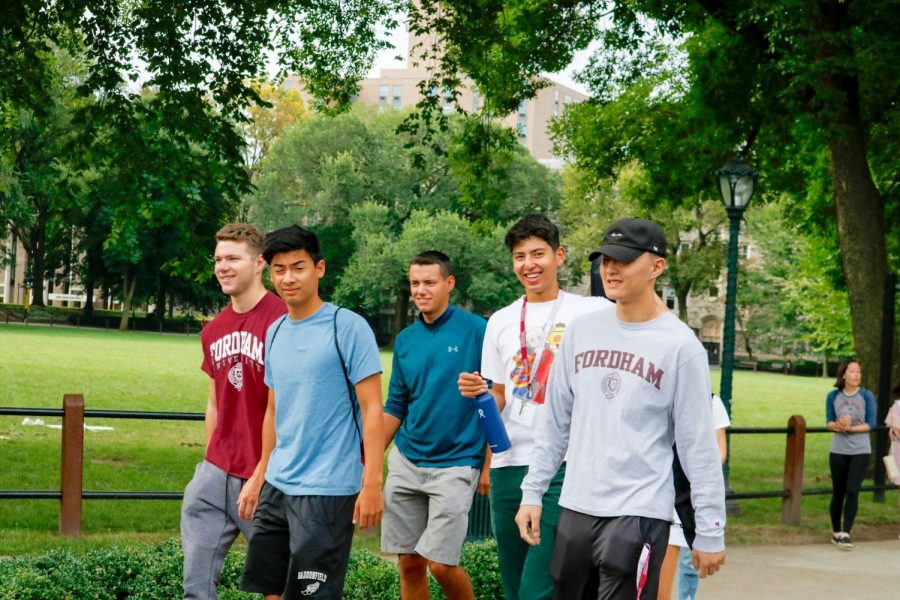Tax Data Reveal Fordham’s High Economic Mobility Rate
Julia Comerford/The Fordham Ram
The New York Times’ data subsite, found that Fordham students are, on average, wealthier when entering the university than they are later in life.
Analysis based on millions of anonymous tax records by the Upshot, The New York Times’ data subsite, found that Fordham students are, on average, wealthier when entering the university than they are later in life. Upon entering Fordham, the average student is in the 78th income percentile in New York state and in the 72nd income percentile as a postgraduate, around age 34.
The study is part of a larger analysis on economic diversity and student outcomes which recognized Fordham as a university with one of the highest mobility rates, a ranking that measures the chance a lower income student has to become a higher income adult and whether recent graduates’ income brackets will surpass their parents’.
A similar report by the Chronicle for Higher Education ranked Fordham number 10 of 40 private four-year institutions in 2017 which led among the nation’s 28 Jesuit universities.
Among private universities, The New York Times reported that of the share of students from the bottom fifth of incomes who move to the top fifth as adults, Fordham ranks 12 out of 71 highly selective private colleges in the U.S.
“This reflects Fordham’s longstanding commitment to foster upward mobility,” said Bob Howe, assistant vice president for communications and special advisor to the president.
According to Howe, this is a major accomplishment for an institution that is outperformed by many private colleges in terms of endowment. He cited Fordham’s recent commitment to a $175 million financial aid campaign as evidence of providing opportunity to lower income students.
The number of Fordham students eligible for federal Pell Grants is 18%, according to Howe. Unlike standard loans, Pell Grants, which are awarded solely based on financial need, do not need to be paid back. This is consistent with Columbia University, where 17% of students receive Pell Grants, and slightly under New York University’s (NYU) 22%.
The National Center for Education Statistics reports that an average of 89% of the university’s beginning students who are entering post-secondary education for the first time receive financial aid.
Despite the university’s commitment to offering financial aid and its trend in upward mobility, the university still has few students from families who make about $20,000 or less per year.
The average number of students entering Fordham in the top 20% and the top 10% income brackets has increased among Fordham students born between 1980 and 1990. In analyzing whether these graduates’ income brackets will surpass that of their parents, the average Fordham student’s median family income is $151,800, and 64% come from the top 20%. Median parent incomes of students at Fordham rank 23 out of the 71 private colleges, and eight out of 173 colleges in New York State, higher than Cornell University, Columbia University and NYU, according to The New York Times.
The Upshot, which based its data on today’s 25-year-olds, generally graduates of the class of 2013, excludes international students or students who could not be linked to their parents’ tax returns in their analysis.
According to the study, the median individual income for a Fordham graduate at age 34 is $63,300, sitting among the highest of colleges in New York state, colleges in the Atlantic 10 Conference, and highly selective private colleges in the U.S.
Though this could be attributed to the high rate of students who already arrive in the top 10% and top 20%, a study conducted by experts at the Lumina Foundation, an outreach organization to expand access to student education, found the income gap, at 7.2%, is quite small between rich students earning more after graduation than poor students.
Roger A. Milici Jr., vice president for development and university relations, suggested that the character of the university might foster this economic mobility.
“We do this because of our deep commitment to remaining a place where talented students can get a world-class Jesuit education regardless of their socioeconomic background. This education, we see again and again, propels our students and alumni forward and helps them fulfill the American Dream.”







































































































































































































